No matter the make-up, the notion of a strike partnership – two out-and-out attackers, often with very different strengths and calling cards, working seamlessly together to become greater than the sum of their parts – inevitably evokes the nostalgic yearning for a bygone era. And whilst teams and coaches can work for days, weeks, even seasons to try and achieve the perfect combinations and link-up between their attacking players, it feels as though the concept of building your team around a single player (or, in this case, pair of players) has died out over the last decade or so. Indeed, much more emphasis these days seems to be placed on a club’s manager, and how successfully they’re able to implement a revolutionary new system; or, even more en vogue, their particular ‘footballing philosophy’.
But just because it seems that the battle on the tactics board is becoming ever more important than the battle on the pitch in modern football, does it mean that potentially antiquated ideas such as strike partnerships can’t still be resurrected, utilised and ultimately lead to success in the Premier League? Well, a closer look at those at the business end of the 2020/21 Premier League table would suggest that, just like vinyl records and Tiger Woods, the concept of classic strike partnerships is back, and back with a vengeance…!
Here, across a three-piece series of articles, we’ll take a look at three teams who have enjoyed great starts to the 2020/21 Premier League season, and whose success can, in large parts, be put down to utilising some variant of a strike partnership – whether conforming to the traditional stereotypes or breaking boundaries, redefining the concept and taking the art of building and unleashing devastating attacking duos to all new heights.
Tottenham Hotspur – Harry Kane & Son Heung-Min
We start with the current Premier League table-toppers, and the manager who, it could be argued, prompted the move away from strike partnerships spearheading successful Premier League teams upon his arrival. Although tactical trends come and go with increasing regularity these days thanks to the reach, appeal and coverage of world football being at its widest ever, it’s no understatement to say that Jose Mourinho instigated the biggest tactical revolution in the English Premier League’s history up to that point.
Since its inception in 1992, the 4-4-2 formation had been considered king throughout the Premier League, with the reliability, symmetry and simplicity of two solid banks of four behind two central strikers invariably seen as the sole winning formula by English coaches in particular. Whether comprised of an ‘in-and-out’ blend of a deep-lying centre forward and on-the-shoulder poacher, or the even more fondly recalled ‘big man/little man’ combination, the goalscoring burden was almost solely placed on a team’s front two. These pairings would invariably be supported by high energy, high work rate central midfielders and pacy, touchline-hugging wingers who all, in their own way, were expected to be creators, but rarely frequent goalscoring threats.
But as Michael Cox explored in his excellently researched and presented books The Mixer and Zonal Marking, there was an overriding feeling that tactically, the English game was being left behind; stubbornly refusing to adapt to any number of tactical innovations that were being honed throughout European and world football. Never was this more evident than when Jose Mourinho took the reins at Chelsea and (admittedly with the help of Roman Abramovich’s considerable finances), sent shockwaves throughout the Premier League, winning the title in his first season in English football, with an (at the time) record points total to boot. And all with only one striker.
Building on his work at Porto, with whom he achieved one of the most unlikely Champions League victories in the competition’s history, Mourinho favoured dropping one of the central strikers to allow him to field a third central midfielder, notionally to ensure the defensive solidity for which he is now (in)famous. There’s no doubting it worked on this level during his debut Chelsea season – his team conceded a record low 15 goals from 38 league games played.
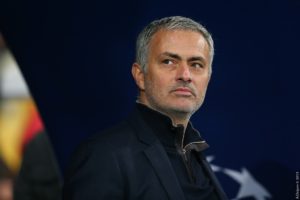
“But where will the goals come from,” detractors cried, “now that your lone striker has been left isolated with nobody to work off?!”
Mourinho, however, determined he had the players and the system to ensure this wasn’t the case. Whilst without the ball, the shape did indeed resemble a rather defensive 4-5-1, Mourinho looked to apply three concepts that, whilst all now staples used in a variety of tactics and systems in 2020, were, at the time, revolutionary innovations that led to almost instant success, namely:
- The notion of a holding midfielder, relying on the prodigious talent and energy of Claude Makelele to cover laterally in front of the back four.
- Switching conventional wingers such as Damien Duff and Arjen Robben to their opposite flanks, introducing the idea of inside forwards or, perhaps more accurately, inverted wingers.
- The concept of taking advantage of the transition phase – once again utilising Makelele’s ball-winning ability and, combined with the pace and drive of attacking players such as Frank Lampard, quickly exploiting spaces left by the opposition immediately after the possession had changed hands.
So what, I hear you ask, does this have to do with strike partnerships? Surely the man that encouraged the move away from rigid 4-4-2 formations and towards more flexible systems which generally only operated with a single out-and-out striker would be the last to value a classic strike partnership? Well, history will prove that, although often labelled as overly stubborn, defensive and inflexible in his approach, Jose Mourinho has constantly looked to subtly tweak and innovate in order to get the best out of his squads, and never has this been more evident than his current transformation of Harry Kane, and Mourinho’s cultivating of the Englishman’s blossoming relationship with Son Heung-Min.
Ever since his breakout season in 2014/15, Harry Kane has typically been the spearhead of Tottenham Hotspur’s attack, leading the line in a manner reminiscent of any number of centre forwards of old. His goalscoring record over the last 5 years, too, suggests that Kane has generally been asked to focus almost solely on what happens in and around the opposition’s 18-yard box. Nobody can argue with the results on a personal level, with Kane’s record of 151 goals in his 221 Premier League matches standing out not just when compared to the top strikers that have plied their trade in the Premier League during the last 5 years, but amongst the league’s all-time greats too.
Yet despite Kane’s success and the personal accolades he has rightfully received, his goalscoring exploits have not led to him lifting any silverware with Spurs… until now, perhaps, courtesy of ‘trophy specialist’ Mourinho, and an alteration that appears to be getting the best out of not only Kane but Son Heung-Min and the entire Tottenham squad.
Whether due to the effects of a string of ankle ligament injuries or a concerted effort by Mourinho to mould Kane into the kind of complete forward he feels is crucial to his footballing philosophy, Kane has notably been appearing in previously unfathomable deeper areas of the pitch this season. Breaking up the play in central midfield, hitting raking 40-yard cross-field balls and even popping up with towering defensive headers and heroic blocks in his own penalty area, there’s no doubt that, whatever the prompt, Harry Kane is operating as a very different kind of centre forward this season, as highlighted by Kane’s individual touch maps vs a variety of opponents in the 2019/20 season (above), compared to his touch maps vs the same opponents this season (below).
Harry Kane’s touch map from Southampton away, Arsenal home, Brighton home (2019/20)
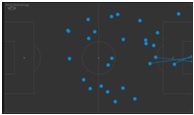
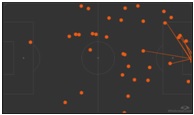
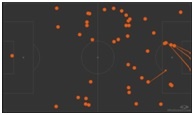
Harry Kane’s touch map from Southampton away, Arsenal home, Brighton home (2020/21)
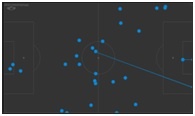
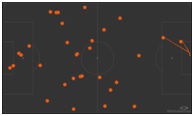
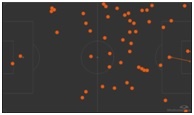
Naturally, you’d assume that operating deeper to such an extent would have a negative effect on Kane’s goalscoring numbers, and whilst his current figure of 0.73 goals per 90 minutes is only good enough to rank as the 4th best out of his previous 7 seasons with Spurs, he has more than made up for it with his contribution in the assist column. Prior to this season, Kane had only weighed in with 18 assists in total in the Premier League, at an average of 3 assists per season. So far in just 11 league matches in 2020/21, the England captain has already supplied 10 assists, meaning he’s averaging an eye-watering 1.65 goal contributions (goals + assists) per 90 minutes so far this term. Whilst you’d expect a natural tempering of those numbers as the campaign progresses, the figures nonetheless provide pretty emphatic vindication for Kane’s change of tack.
But it’s not just Harry Kane who has seen an uplift in his statistics this season – Kane’s new partner in crime and Spurs’ other elite attacking threat, Son Heung-Min, has also benefited from the new approach. Kane operating deeper has naturally allowed a little more space in the channels and in behind teams as opposition defenders, wary of allowing a world-class talent like Harry Kane too much time and space, have been drawn unconsciously out of their ideal area of operations.
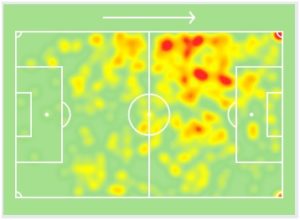
Son Heung-Min has, to his credit, taken advantage of these gaps in opposition defences, to devastating effect. Whilst still operating from a predominantly very wide average position out on the left (as highlighted by his ‘season heatmap’ below), he has nonetheless relished in his new role as Tottenham’s focal point in the final third, regularly using his blistering pace to turn good chances into great chances.
His finishing this season, too, backs up the case for having Son as the attacker best positioned to take advantage of Spurs’ updated approach – he has hit 10 goals from his 11 league appearances so far this season, yet his xG (expected goals) is only 3.9, highlighting he is consistently putting away objectively difficult chances. His conversion rate, too, is a mind-boggling 48%, with his 10 goals coming from just 21 shots taken.
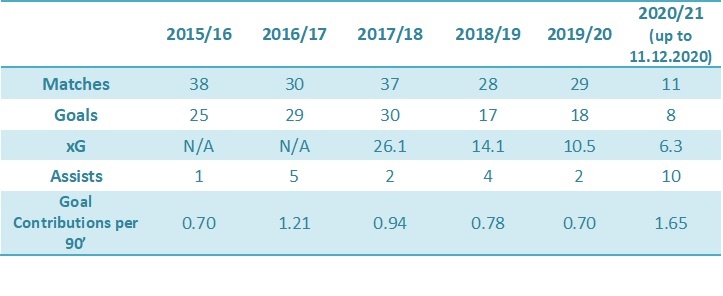
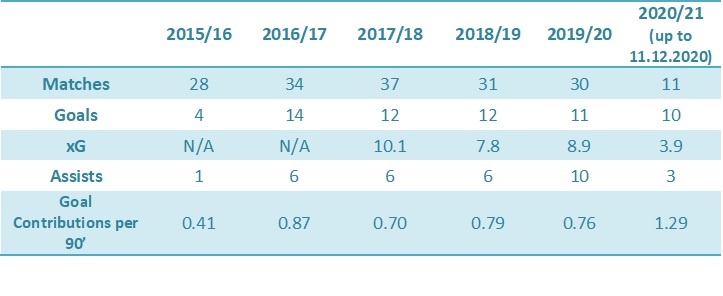
So what can we take from all this? Well, besides the fact that both Harry Kane and Son Heung-Min are statistically in the form of their lives right now, it is clear that, in adapting Harry Kane’s role, in particular, to fit within the construct of his preferred tactical system, Jose Mourinho has, perhaps unwittingly, created a tactical phenomenon – namely, he has forged strike partners out of two players, neither of whom are operating in a role anywhere close to the traditional centre forwards of yesteryear. And in doing so, Mourinho has created seemingly one of the most effective kinds of classic, nostalgia-inducing strike partnerships, the likes of which he almost single-handedly eradicated when he first took charge of a Premier League team, over fifteen years ago.









One Response
Beautiful write-up.
The background on Mourinho really set the rest up nicely. We hear about Pep and Klopp as master tacticians so much we forget just how influential The Special One is.